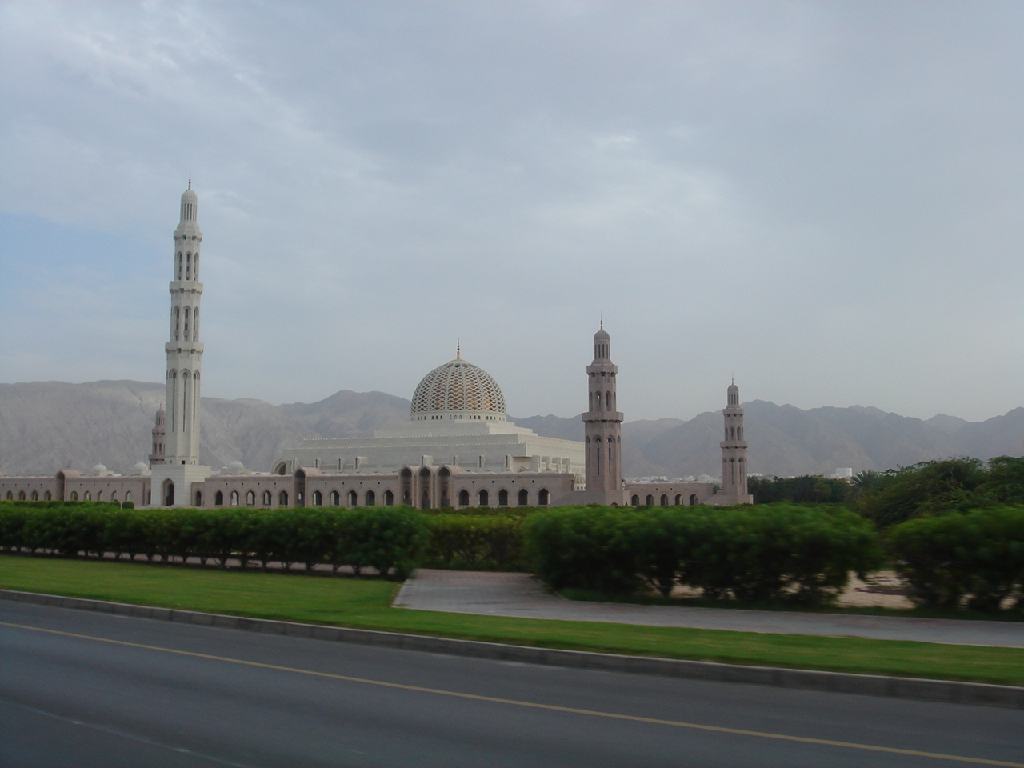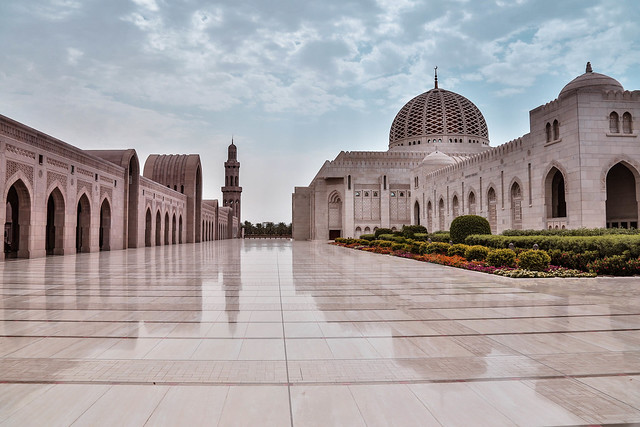It's worth the long haul flight just to see Muscat's Sultan Qaboos Grand Mosque.
This is an architectural and artistic wonder of the world, on par with any of the great cathedrals of Europe. Most delightful to my eyes, it's a celebration of traditional craftsmanship, with stone carving, pietra dura work, hand knotted carpets, etc. on par with masters of the pre-Industrial Age. Despite the fact the building was just completed in 2001. Like the restoration of Windsor Castle or the National Cathedral in Washington D.C., the Mosque assures us that these artists still exist. And what beauty they create here.
Please put aside your religious prejudices and tour with an open mind, seeing this simply ... like any church or temple ... as a place to engender quiet reflection and get closer to God. And do go with a local guide. You'll be hearing a lot about ours, the resonantly-named Yousuf bin Ali bin Yousuf al Balushi, in the coming stories. While you can wander around yourself with a guidebook, having someone who knows the details and purpose of all the rituals completes the experience. (In the same way you'll never fully appreciate Chartres unless you grew up, or are taken around by, a Roman Catholic.)
The entire complex is walled, much like a medieval cathedral close. It's dominated by its enormous dome and four graceful minarets, made all the more impressive because nothing in the surrounding area in more than a few stories tall.
You enter through a garden, an integral part of the experience. We hear a lot about jihadis getting hundreds of virgins in heaven. The more rational promise in the Koran, and one that's driven artistic life for centuries, rewards belief with "gardens, beneath which rivers flow ... and goodly dwellings in gardens of perpetual abode." In a land of brutal heat, pale desert and stony mountain, the appeal of the garden is obvious. You step from a harsh, hot world into one of ordered greenery, clipped hedges and pristine lawns, bisected by rills of water fed by gurgling fountains. Blooming hedges and trees ... jasmine, hibiscus, rose, frangipani ... scent the air. And because Arabic architecture is obsessed by symmetry, each intersection and line of view opens up another photo opp.
Your first stop is the women's prayer hall, much smaller than the main hall for the men because women ... with the responsibilities for the home and children ... are excused from the rigorous 5-a-day prayer schedule of the men. (Yes, of course, as a Western woman I have problems with gender differences in Islam. But we're putting aside prejudices, remember? I'm telling you about a building and what happens inside it, not commenting on a religion.) It's a soul-soothing rectangle of pale marble and crystal chandeliers suspended from a wooden-beamed, geometrically patterned ceiling. Verses from the Koran provide the decoration carved into the upper walls, the flowing nature of Arabic script almost as floral as the arabesque decoration around door frames. A row of intricately carved wooden doors topped with pointed arches faces Mecca, and thus the courtyard and men's prayer hall beyond. Each is topped with windows, adding ... one assumes ... a sense of shared community to the divided sexes.
But the real fireworks, as you might expect, are in the main hall. Which, btw, I was not sure I was going to be able to see as a Christian and a woman. But tourists of all religions and sexes are welcome as long as they're dressed appropriately. (Clearly, I am shockingly bad at arranging a headscarf since Yousuf, a model of elegant civility, could hardly restrain his chuckle when he saw me that morning.)
The architects have pulled that time-honoured trick of extreme contrast. You enter from an arcaded courtyard of pristine, white Carrara marble. There's minimum decoration. And despite this coolest of potential materials, it's already blazing hot. And then you step through the doors. Into colour, pattern and decorative magnificence on a jaw dropping scale. And the temperature has decreased radically, as if you've just jumped into a cold pool on an uncomfortably hot day. You'll need several moments, once over the threshold, to restore your equilibrium.
The first thing you'll notice is the dome. Since Islam forbids the representation of both God and the human form, there's no swirl of clouds, saints and gambolling angels to fall back on here. Instead the garden has come inside, with floral arabesques in inlaid marbles and gold filling geometric patterns rising to the apex. Dropping from the centre is more a feat of engineering than a chandelier: German crystal, 14 meters long. To put that in perspective, it's bigger than a London double-decker bus and the second largest in the world.
It illuminates the world's second largest hand-woven carpet, mosaic alcoves, pietra dura panels and carved window screens. (Note the "seconds"? Both were firsts just a few years ago. It seems there's an architectural arms race going on with new mosques in the Arabian penninsula.) Any single square meter would be worth your attention for its decorative detail. Taken all together, it's almost overwhelming. A feeling enhanced by the interior architecture, While Christian cathedrals normally have a long nave with screening columns that reveal their decorative gems a bit at a time, the space here has just four supporting columns. Meaning all the decoration is laid before you in one mind-numbing blast. If you're the type who treasures the austerity of Scandinavian design, you might find this a bit hard to take.
These are the highlights of the complex but, if you wanted to linger, there's more to see. Courtyards and arcades expand the overall capacity of the complex to a staggering 20,000. (Expanding from 750 in the women's hall, and 6,500 in the main hall.) Like Christian monasteries, these are religious complexes with facilities for more than just religious services. There's a library, school and meeting rooms. There are also washing facilities, still part of Islamic ritual though it fell out of Christian tradition centuries ago. It struck me that, minus a few angels on vault bosses, the washing courtyard here bears a striking resemblance to the monks' lavatorium at Gloucester Cathedral.
All these areas have more fine decorative detail to delight your eyes. For example, between the arches in one arcade are mosaics representing the carpet styles of various tribes from Iran and Iraq. In London, it would be a special exhibit at the Victoria and Albert to keep you captivated for an hour or two. But here, it was just a drop in the ocean.
We needed to move on, however. There are plenty of other things to see in Muscat, and we only had a day to do it. Next entry: on to the old town.



No comments:
Post a Comment